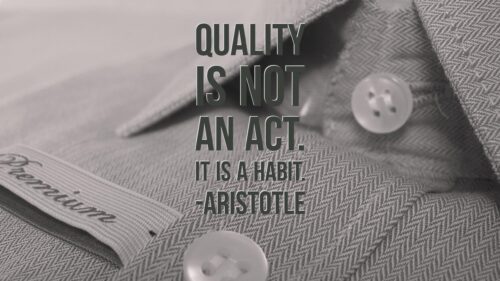eLearning Quality – What Does it Mean to You?
Be a yardstick of quality. Some people aren’t used to an environment where excellence is expected. – Steve Jobs
We all want to be excellent at what we do. And pushing the boundaries and expectations of quality is admirable. But be careful to measure the quality of the right things. And measure the right things against the right metrics. The levels of quality differ for the same solution when measured against different metrics.
I still remember one of the first elearning projects I was asked to produce as a full-time employee. I actually remember the meeting about the project more than I remember the project itself. This is the project I had been preparing to create for many years. Hours and hours of studying in graduate school. Many more hours, weeks, months, spent learning authoring tools and producing projects. My schooling had prepared me to be the most thorough of eLearning practitioners. However, it did not prepare me for the reality gut check of the modern business world.
The topic: Electrostatic Discharge.
The deadline: 5 Days.
My attitude: HELL NO!
No joke! After all, I was a graduate educated professional with all the skills and credentials to produce the most mind blowing eLearning course one could possibly imagine. How dare they ask me to perform my magic in 5 days. I needed 5 weeks…at a minimum. There was an analysis that need to be completed, a design process with review cycle, time for development work, and then it needed to be tested to insure effectiveness. And then, or course, re-analized, redesigned, and reproduced, and finally delivered. It was just not possible to achieve a satisfactory level of quality in 5 days.
I was all about quality. I knew better than anyone in that business what quality eLearning was, and how to produce it. But why didn’t they understand? Why couldn’t they see how my 5 week marathon would produce a far superior training solution than a 5 day sprint? These questions haunted me for years even after that first project.
My graduate school programming was strong. But over time the realities of business slowly deprogrammed my academic mindset of quality. I came to think more like an entrepreneur, and less like an academic. This does not mean that raising the corporate training bar to academic standards is a bad thing. It simply means that in the business world it’s not necessary. And, in fact, going that far would be a bad business decision in many cases.
The idea of quality is complex. When we request “high quality” what exactly is it that we are requesting? When we condemn others’ quality how is it justified? When you look at a painting by Van Gogh, you immediately assume high quality because it bears his name and others have told you he’s a pretty good painter. But is he? Have you seen his earliest works that also bear his name? Yikes! Is a short video followed by a quiz and navigated by a “next” button really poor quality? Is powerpoint really inferior to Captivate, Storyline, and others?
What is Quality Training?
Google defines quality as “the standard of something as measured against other things of a similar kind.” In my interpretation this definition tells me that the quality of my training solution is measured against all other similar training solutions. In this case all other self-paced, interactive, computer-based training. And this was absolutely how I measured myself and the quality of my work in the early days.
But as I matured in my career I discovered a better definition. The definition stated by the ISO 8402-1986 standard which defines quality as “the totality of features and characteristics of a product or service that bears its ability to satisfy stated or implied needs.” I could be wrong in my interpretation, but I read that as “its of high quality if it meets the objectives of the business.”
In my first project as a full time employee, my definition of quality was not in synch with my manager’s. In his mind the need was simple: Take this workbook and make it digital so we don’t need to waste resources running the classroom training version every week. While meeting my quality standards, at the time, required 5 weeks, 5 days was plenty of time to meet his business need. Today, I could meet that business need in less than 5 hours. And be quite happy with it’s quality.
I am not arguing that our industry needs to lower its expectations of quality. But I am convinced that changing our perspective on quality could make us happier and achieve more for the businesses we serve.
Just because we change our perception of quality does not mean we are lowering the bar of quality. It simply means we are choosing to see quality through a different lens. The lens of the business you serve does not focus on the highest quality award winning training solution as defined by your peers and other training solutions within other companies. Instead it rewards you for supporting the needs of the business quickly and efficiently.






